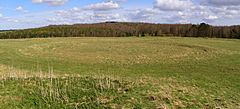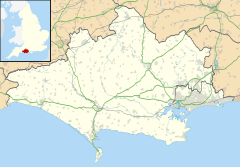Oakley Down Barrow Cemetery facts for kids

One of the disc barrows
|
|
| Location | near Sixpenny Handley, Dorset |
|---|---|
| Coordinates | 50°57′15″N 1°58′31″W / 50.95417°N 1.97528°W |
| History | |
| Periods | Bronze Age |
| Site notes | |
| Excavation dates | Early 19th century |
| Archaeologists | Sir Richard Colt Hoare and William Cunnington |
| Designated | 15 October 1924 |
| Reference no. | 1002674 |
Oakley Down Barrow Cemetery is an ancient burial ground from the Bronze Age. It's located on Cranborne Chase in Dorset, England, about 1 mile (1.6 km) east of Sixpenny Handley. This special place is protected as a scheduled monument.
Contents
What is Oakley Down Barrow Cemetery?
Oakley Down Barrow Cemetery is a collection of ancient burial mounds. These mounds are called round barrows. They were built during the Bronze Age, a time when people started using bronze tools.
Many other ancient sites are found on Cranborne Chase. These include places from the Neolithic period (the New Stone Age) and the early Bronze Age. A very old long burial mound, called Wor Barrow, is nearby. It might have influenced why people chose this spot for the Oakley Down cemetery.
Types of Burial Mounds
There are about 30 burial mounds at Oakley Down. Most of them are found between the A354 road and the Ackling Dyke Roman road.
The main group of mounds includes different types:
- Bowl barrows: These look like upside-down bowls. They are usually 11 to 26 meters (36 to 85 feet) wide. Their height ranges from 0.3 to 3.4 meters (1 to 11 feet).
- Disc barrows: These have a flat, circular area surrounded by a ditch and a bank. There are five or six of these, about 12 to 29 meters (39 to 95 feet) wide.
- There are also two oval barrows and one bell barrow. Bell barrows have a mound surrounded by a flat area and then a ditch and bank, like a bell.
A smaller group of mounds is located to the north. This group has four bowl barrows and another bell barrow.
Who Explored These Mounds?
Many of the barrows were dug into in the early 1800s. Two famous archaeologists, Sir Richard Colt Hoare and William Cunnington, led these explorations. We can still tell which mounds they investigated by looking at Hoare's old maps.
Inside the barrows, archaeologists found different kinds of burials. Some were primary burials, meaning the first person buried there. Others were secondary, meaning someone was buried later. They found both inhumations (whole bodies) and cremations (burnt remains). The cremated remains were often placed in urns (pots) or cists (stone boxes).
What Was Found Inside?
The archaeologists also discovered "grave goods." These are items buried with the dead. They included beautiful beads made of amber, glass, and faience. Faience is a type of glazed pottery. They also found bronze daggers. Some of these amazing finds are now kept at the Wiltshire Museum.
In 1970, part of one bowl barrow was dug up again. This excavation revealed a posthole near the edge of the mound. A posthole is a hole where a wooden post once stood. Close by, there was a pit containing burnt bone and ash. This might have been where a cremation pyre (a pile of wood for burning a body) was located.


